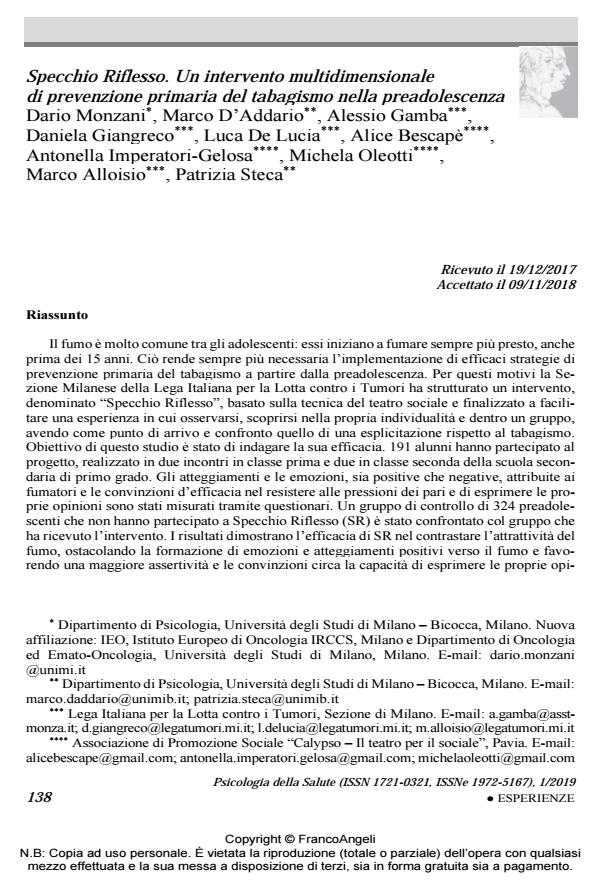Specchio Riflesso. A multidimensional intervention for the primary prevention of cigarette smoking during pre-adolescence
Journal title PSICOLOGIA DELLA SALUTE
Author/s Dario Monzani, Marco D’Addario, Alessio Gamba, Daniela Giangreco, Luca De Lucia, Alice Bescapè, Antonella Imperatori-Gelosa, Michela Oleotti, Marco Alloisio, Patrizia Steca
Publishing Year 2019 Issue 2019/1
Language Italian Pages 18 P. 138-155 File size 276 KB
DOI 10.3280/PDS2019-001008
DOI is like a bar code for intellectual property: to have more infomation
click here
Below, you can see the article first page
If you want to buy this article in PDF format, you can do it, following the instructions to buy download credits

FrancoAngeli is member of Publishers International Linking Association, Inc (PILA), a not-for-profit association which run the CrossRef service enabling links to and from online scholarly content.
Smoking is very common among adolescents; nowadays, young people start smoking very early, before being 15 years old. Effective primary prevention interventions are needed to contrast tobacco use in young age. For these reasons, the section of Milan of the Italian League for the Fight Against Cancer has developed Specchio Riflesso (SR), an innovative intervention based on the social theatre methodology and aimed at promoting preadolescents’ self-reflection on their identity and their role within a group and facilitating their critical reflection toward tobacco smoking. Aim of this contribution was to evaluate its effectiveness. One hundred and ninety-one students were involved in SR, consisting of two sessions in the first class and two sessions in the second class of the secondary school. Positive and negative emotions and attitudes toward smoking, and self-efficacy to resist peer pressure and to express opinions have been assessed trough questionnaires. A group of 324 preadolescents not involved in SR has been compared to the experimental group undergoing intervention. Results attest the efficacy of SR to diminish the attractiveness of cigarettes, by counteracting the formation of positive emotions and attitudes toward smoking and promoting higher assertiveness and self-efficacy to express opinions. To sum up, SR is an effective intervention to prevent tobacco use in secondary school. .
Keywords: Tobacco use, preadolescence, primary prevention, attitudes, self-efficacy
Dario Monzani, Marco D’Addario, Alessio Gamba, Daniela Giangreco, Luca De Lucia, Alice Bescapè, Antonella Imperatori-Gelosa, Michela Oleotti, Marco Alloisio, Patrizia Steca, Specchio Riflesso. Un intervento multidimensionale di prevenzione primaria del tabagismo nella preadolescenza in "PSICOLOGIA DELLA SALUTE" 1/2019, pp 138-155, DOI: 10.3280/PDS2019-001008